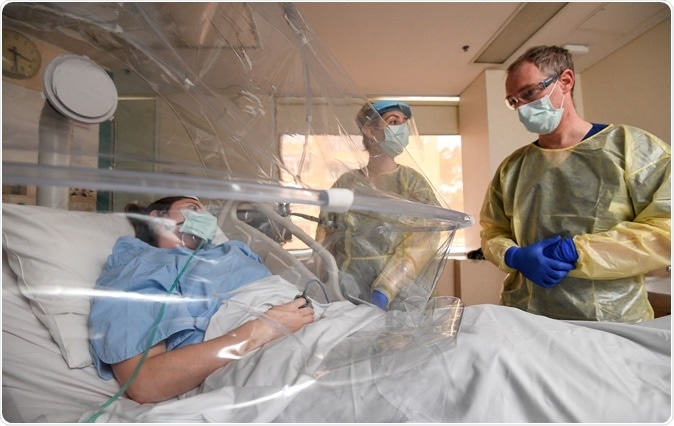Researchers from the University of Melbourne have come up with devices called ventilation hoods that could help decrease the spread of COVID-19 from ICU patients to health workers who treat them, and to other patients.
The coronavirus 2019 disease (COVID-19) has swept the globe over the last months, causing panic, and country-wide lockdowns in unceasing efforts to stem the spread of the virus.
With the number of deaths skyrocketing and morgues filled with bodies, governments, and healthcare systems worldwide are struggling. Structurally similar to the severe acute respiratory syndrome (SARS) virus in 2003, the novel coronavirus SARS-CoV-2 spreads with celerity from person to person, primarily through infected respiratory droplets.

The device has been prototyped and tested by researchers in consultation with infectious disease experts at Western Health to ensure that its application is practical, hygienic, effective and safe. Image: Penny Stephens
Unceasing risk
Those who are most at risk, however, are also those who are most indispensable – the health workers who treat the ill. Spending large portions of their day among the infected, their chances of contracting the infection are much higher than others. When they contract the virus, however, they both deprive the already overtaxed healthcare system of a worker and burden it with one more case to treat.
Support for healthcare workers
In the face of this bleak picture. Western Health and the University of Melbourne offer a ray of hope, reacting with agility to the need to “help protect healthcare staff working on the frontline.”
Western Health has collaborated with researchers from the University to produce a new device to protect healthcare professionals in the fight against the spread of the coronavirus (COVID-19) pandemic.
In Spain and Italy, 15% of healthcare workers who treat patients infected with the coronavirus end up getting infected themselves. This turns the doctors themselves into patients, triggering a vicious cycle of more patients and fewer doctors.
Professor Jason Monty, a professor of fluid dynamics and lead researcher at the University of Melbourne, says he was contacted in late March by Assistant Professor Forbes McGain of Western Health “who asked us to look into the safety and well-being of healthcare workers while they’re attending to infected patients.” The idea was to facilitate patient care by healthcare workers while keeping COVID-19 patients with critical illness in individual isolation.
McGain, who is an honorary member of the University of Melbourne’s Center for Intensive Critical care, discussed the idea of isolating these COVID-19 patients with Professor Monty. After weighing the complexities of the problem, he and his team started working on a solution.
Containing droplets through ventilation hoods
COVID-19 is spread primarily by infection-bearing droplets expelled by infected individuals through coughing or sneezing. Droplet transmission occurs through such acts as people within one meter of the infected individual. This places healthcare workers at high risk.
To combat this, Melbourne University has created a personal ventilation hood that blocks these droplets, preventing them from coming into contact with healthy individuals. These hoods are designed for use with people who are critically ill with the coronavirus and in intensive care.
Researchers design ventilation hoods for hospital beds to help contain COVID-19 spread
Monty and McGain came up with the concept of these hoods and then worked with a team of researchers from Melbourne University’s School of Engineering to bring the concept into reality.
The hoods are made of clear, flexible plastic. This allows healthcare workers to assess the patient’s condition visually, as well as allowing for verbal communication. They’re designed to cover the top half of a hospital bed, shielding the patient’s head and chest region.
The hoods will block the relatively larger droplets that are expelled through a cough or sneeze, while smaller droplets are whisked away by a system incorporated in the hood assembly, through a high-efficiency particulate air filter. Using these hoods, doctors and nurses can now move among and treat the critically ill with less risk of contracting the virus themselves. In countries such as Italy and the USA, where the healthcare system is already overwhelmed, this could be a godsend.
This device has been designed and tested by a team of fluid dynamics researchers in consultation with healthcare workers and infectious disease experts from Western Health to ensure that it’s efficient, safe, and hygienic. The R&D team has used low-cost components that are readily available to ensure that these devices can be economically produced in low-income countries.
The hoods are being deployed at Footscray Hospital, one of the three major hospitals operated by Western Health. Patient trials should begin this week, and if all goes well, the hoods will start being used with coronavirus patients next week.
Professor Monty says that while they are currently working to supply Australian hospitals with these hoods, they do hope to spread this technology across the globe in the coming months.